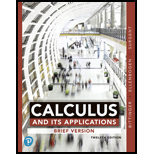
CALCULUS+ITS APPLICATIONS
12th Edition
ISBN: 9780135164884
Author: BITTINGER
Publisher: PEARSON
expand_more
expand_more
format_list_bulleted
Concept explainers
Question
Chapter CR, Problem 5CR
To determine
Find the limit
Expert Solution & Answer
Want to see the full answer?
Check out a sample textbook solution
Students have asked these similar questions
I need help making sure that I explain this part accutartly.
Please help me with this question as I want to know how can I perform the partial fraction decompostion on this alebgric equation to find the time-domain of y(t)
Please help me with this question as I want to know how can I perform the partial fraction on this alebgric equation to find the time-domain of y(t)
Chapter CR Solutions
CALCULUS+ITS APPLICATIONS
Ch. CR - Prob. 1CRCh. CR - Prob. 2CRCh. CR - Prob. 3CRCh. CR - Prob. 4CRCh. CR - Prob. 5CRCh. CR - Prob. 6CRCh. CR - Prob. 7CRCh. CR - Prob. 8CRCh. CR - Prob. 9CRCh. CR - Prob. 10CR
Ch. CR - Prob. 11CRCh. CR - Prob. 12CRCh. CR - Prob. 13CRCh. CR - Prob. 14CRCh. CR - Prob. 15CRCh. CR - Prob. 16CRCh. CR - Prob. 17CRCh. CR - Prob. 18CRCh. CR - Prob. 19CRCh. CR - Prob. 20CRCh. CR - Prob. 21CRCh. CR - Prob. 22CRCh. CR - Prob. 23CRCh. CR - Prob. 24CRCh. CR - Prob. 25CRCh. CR - Prob. 26CRCh. CR - Prob. 27CRCh. CR - Prob. 28CRCh. CR - Prob. 29CRCh. CR - Prob. 30CRCh. CR - Prob. 31CRCh. CR - Prob. 32CRCh. CR - Prob. 33CRCh. CR - Prob. 34CRCh. CR - Prob. 35CRCh. CR - Prob. 36CRCh. CR - Prob. 37CRCh. CR - Prob. 40CRCh. CR - Prob. 41CRCh. CR - Prob. 42CRCh. CR - Prob. 43CRCh. CR - Prob. 44CRCh. CR - Prob. 45CRCh. CR - Prob. 46CRCh. CR - Prob. 47CRCh. CR - Prob. 48CRCh. CR - Prob. 49CRCh. CR - Prob. 50CRCh. CR - Prob. 52CRCh. CR - Prob. 54CRCh. CR - Prob. 55CRCh. CR - Prob. 56CRCh. CR - Prob. 57CRCh. CR - Prob. 58CRCh. CR - Prob. 59CRCh. CR - Prob. 61CRCh. CR - Prob. 62CRCh. CR - Prob. 63CRCh. CR - Suppose the rate of change of y with respect to x...Ch. CR - Prob. 65CRCh. CR - Prob. 66CRCh. CR - Prob. 67CRCh. CR - Prob. 68CRCh. CR - Prob. 69CRCh. CR - Prob. 70CRCh. CR - Prob. 71CRCh. CR - Prob. 72CR
Knowledge Booster
Learn more about
Need a deep-dive on the concept behind this application? Look no further. Learn more about this topic, calculus and related others by exploring similar questions and additional content below.Similar questions
- Evaluate F³ - dr where ♬ = (4z, -4y, x), and C' is given by (t) = (sin(t), t, cos(t)), 0≤t≤ñ .arrow_forwardMid-Term Review Find the formula for (f + g)(x). f(x) = x² - 10x + 25 and g(x) = x² - 10x + 24 (f + g) (x) = [ 2 ]x² X + DELL Skip Sarrow_forwardCalculus III May I please have some elaborations on Example 2 part a? Thank you.arrow_forward
- 1. A bicyclist is riding their bike along the Chicago Lakefront Trail. The velocity (in feet per second) of the bicyclist is recorded below. Use (a) Simpson's Rule, and (b) the Trapezoidal Rule to estimate the total distance the bicyclist traveled during the 8-second period. t 0 2 4 6 8 V 10 15 12 10 16 2. Find the midpoint rule approximation for (a) n = 4 +5 x²dx using n subintervals. 1° 2 (b) n = 8 36 32 28 36 32 28 24 24 20 20 16 16 12 8- 4 1 2 3 4 5 6 12 8 4 1 2 3 4 5 6arrow_forward= 5 37 A 4 8 0.5 06 9arrow_forwardConsider the following system of equations, Ax=b : x+2y+3z - w = 2 2x4z2w = 3 -x+6y+17z7w = 0 -9x-2y+13z7w = -14 a. Find the solution to the system. Write it as a parametric equation. You can use a computer to do the row reduction. b. What is a geometric description of the solution? Explain how you know. c. Write the solution in vector form? d. What is the solution to the homogeneous system, Ax=0?arrow_forward
- 2. Find a matrix A with the following qualities a. A is 3 x 3. b. The matrix A is not lower triangular and is not upper triangular. c. At least one value in each row is not a 1, 2,-1, -2, or 0 d. A is invertible.arrow_forwardFind the exact area inside r=2sin(2\theta ) and outside r=\sqrt(3)arrow_forwardA 20 foot ladder rests on level ground; its head (top) is against a vertical wall. The bottom of the ladder begins by being 12 feet from the wall but begins moving away at the rate of 0.1 feet per second. At what rate is the top of the ladder slipping down the wall? You may use a calculator.arrow_forward
arrow_back_ios
SEE MORE QUESTIONS
arrow_forward_ios
Recommended textbooks for you
- Algebra & Trigonometry with Analytic GeometryAlgebraISBN:9781133382119Author:SwokowskiPublisher:Cengage
 Algebra: Structure And Method, Book 1AlgebraISBN:9780395977224Author:Richard G. Brown, Mary P. Dolciani, Robert H. Sorgenfrey, William L. ColePublisher:McDougal Littell
Algebra: Structure And Method, Book 1AlgebraISBN:9780395977224Author:Richard G. Brown, Mary P. Dolciani, Robert H. Sorgenfrey, William L. ColePublisher:McDougal Littell

Algebra & Trigonometry with Analytic Geometry
Algebra
ISBN:9781133382119
Author:Swokowski
Publisher:Cengage

Algebra: Structure And Method, Book 1
Algebra
ISBN:9780395977224
Author:Richard G. Brown, Mary P. Dolciani, Robert H. Sorgenfrey, William L. Cole
Publisher:McDougal Littell
Limits and Continuity; Author: The Organic Chemistry Tutor;https://www.youtube.com/watch?v=9brk313DjV8;License: Standard YouTube License, CC-BY